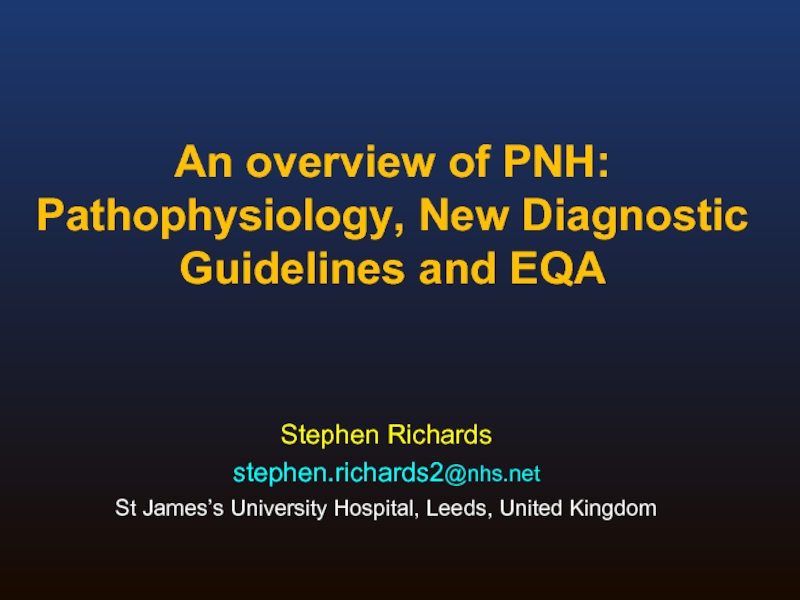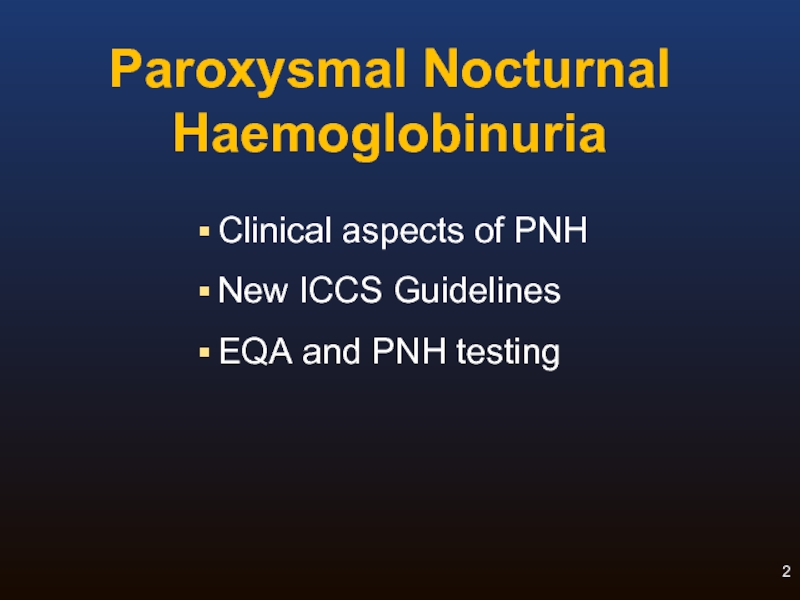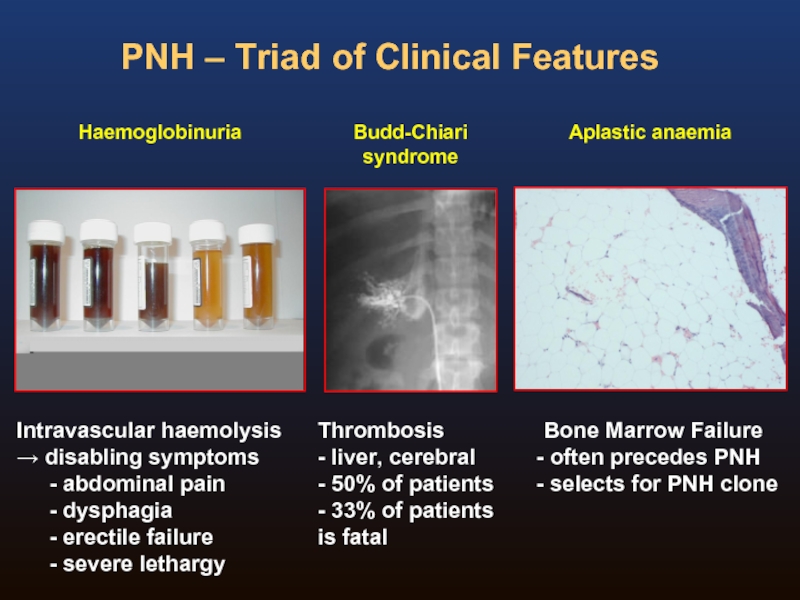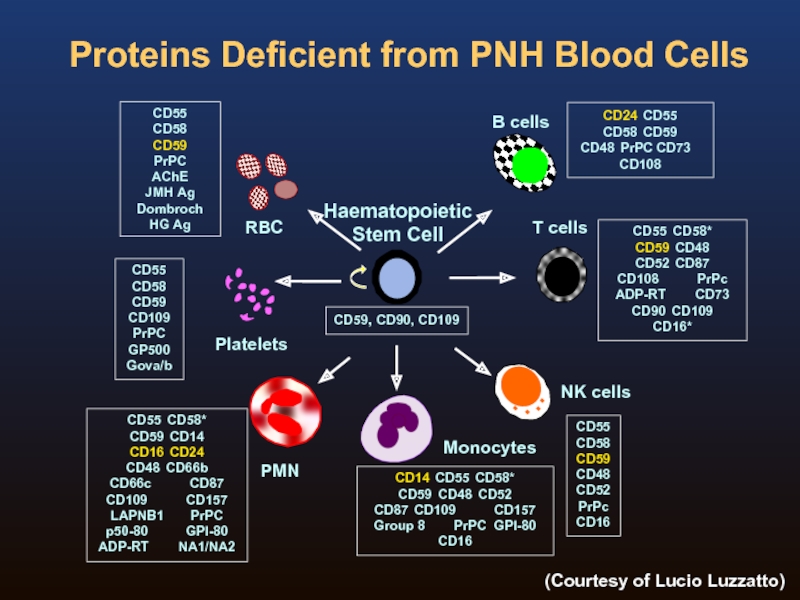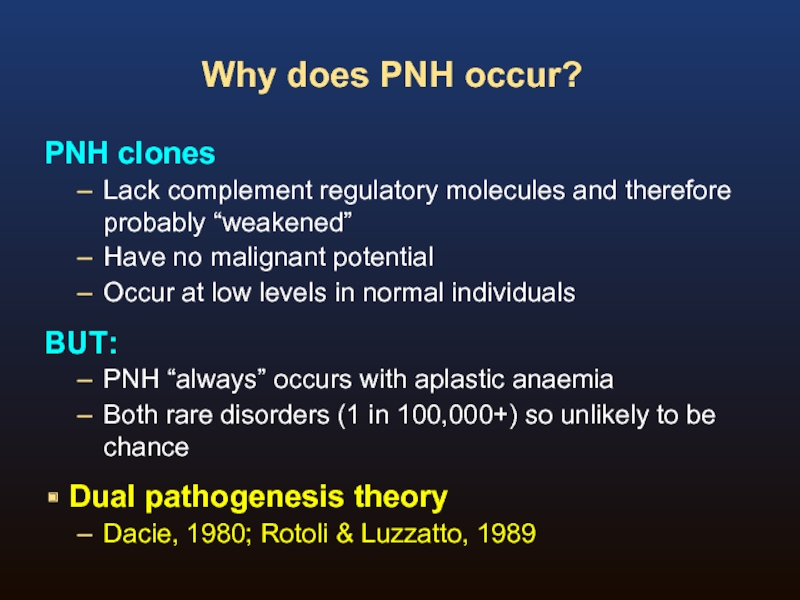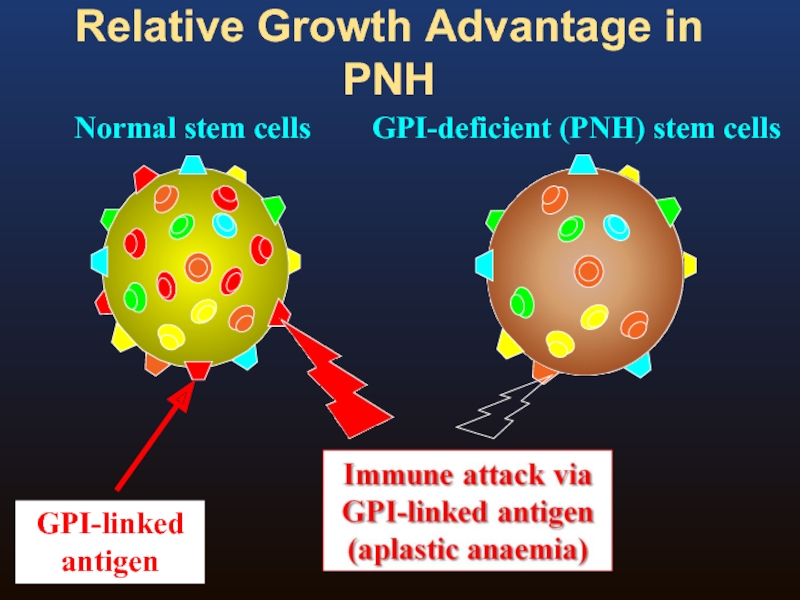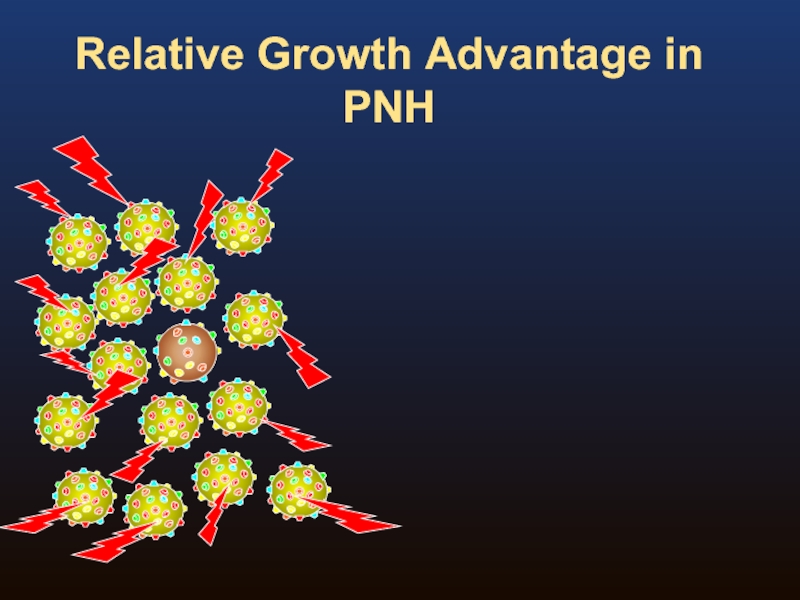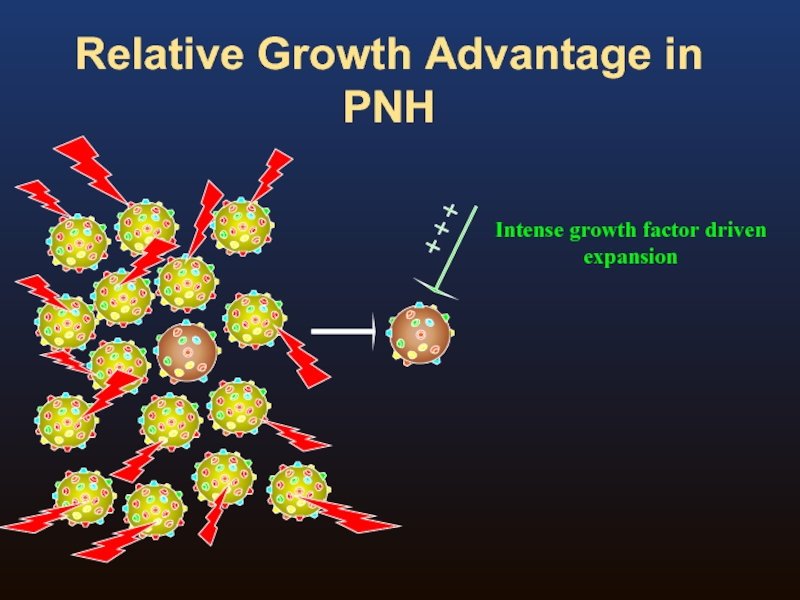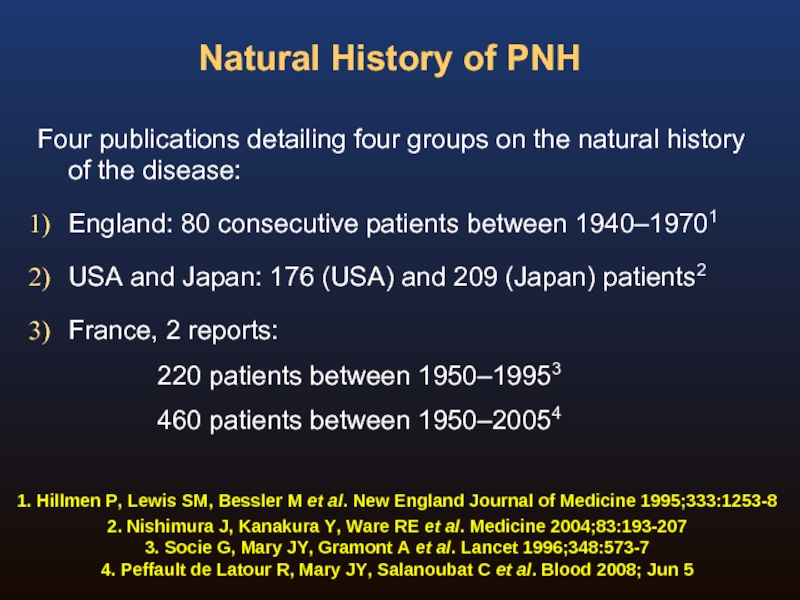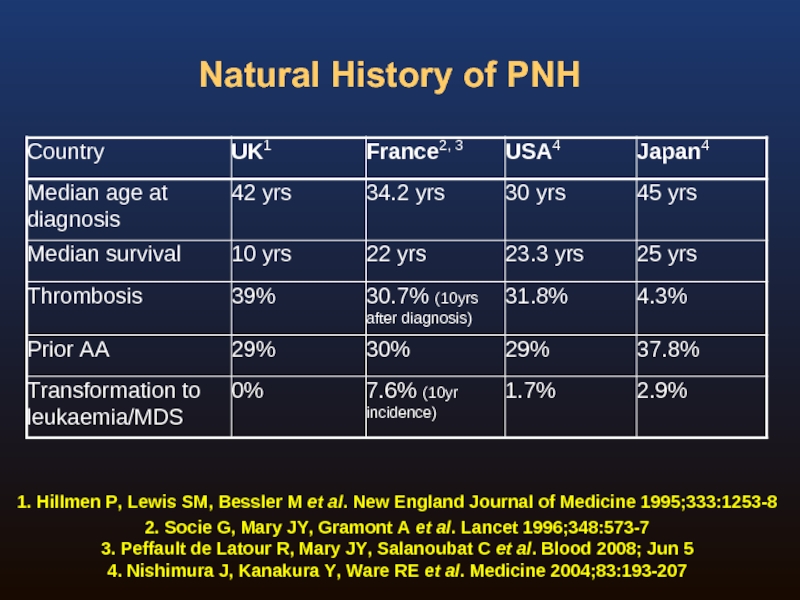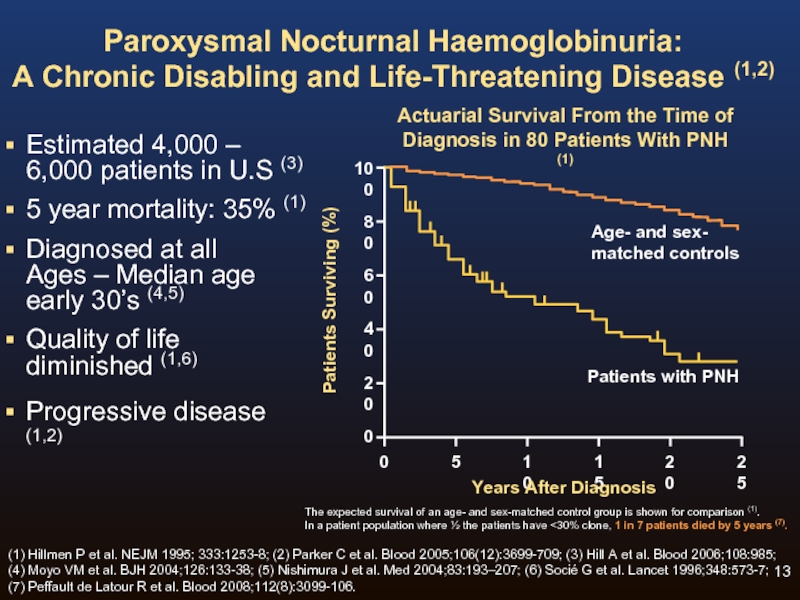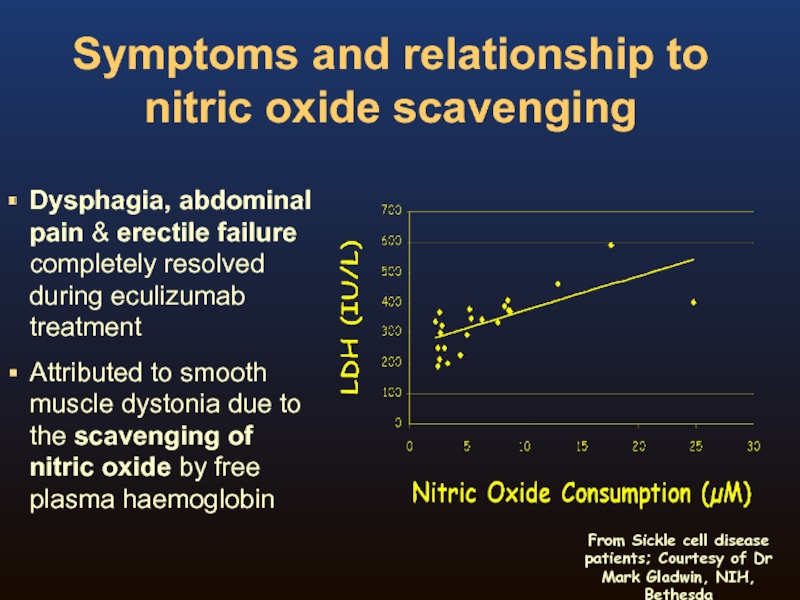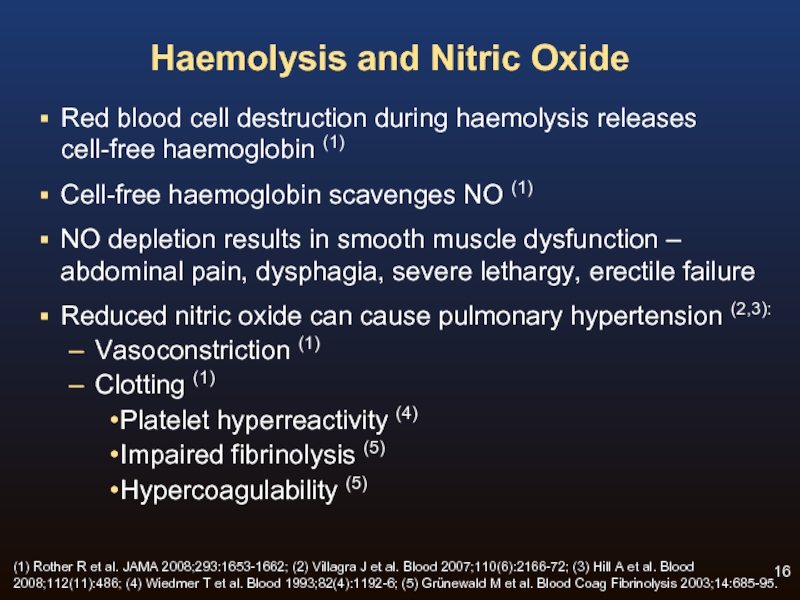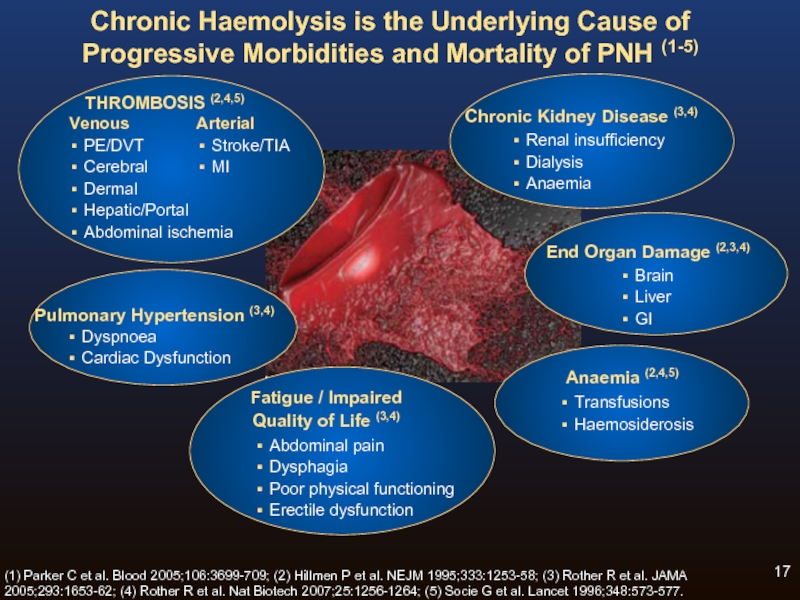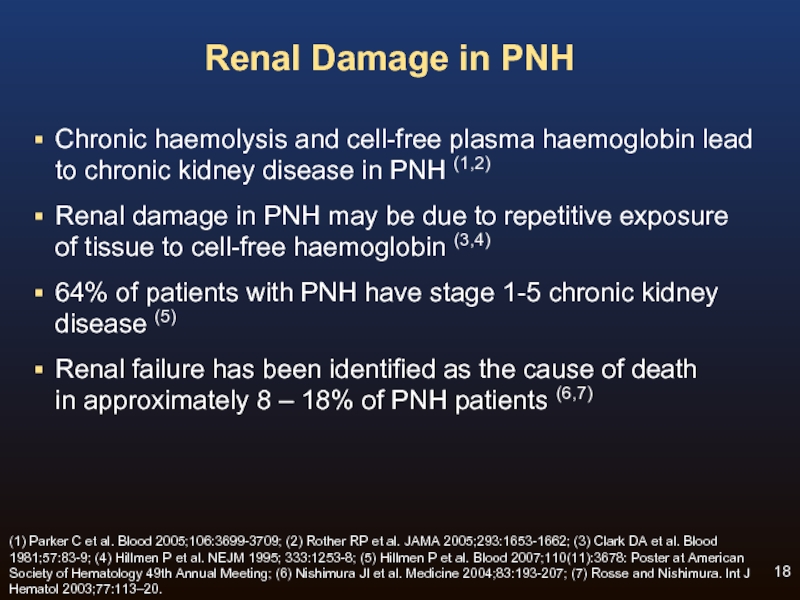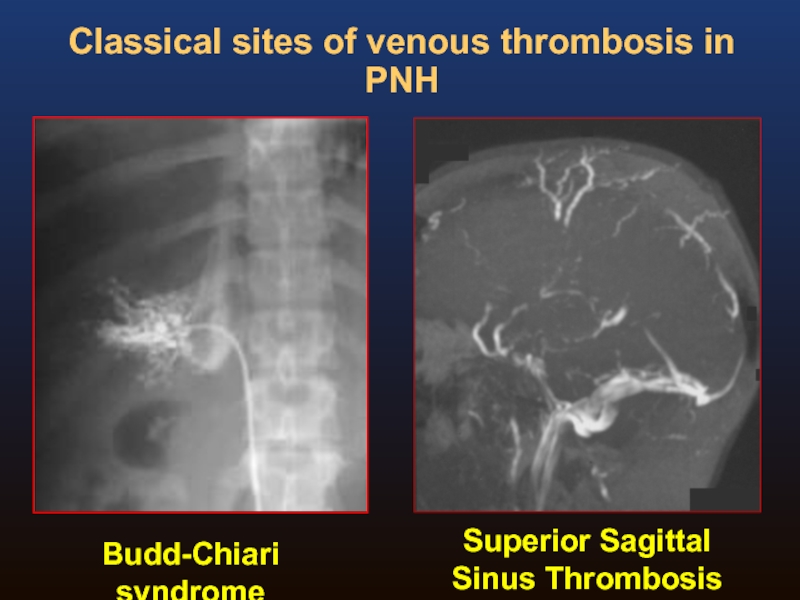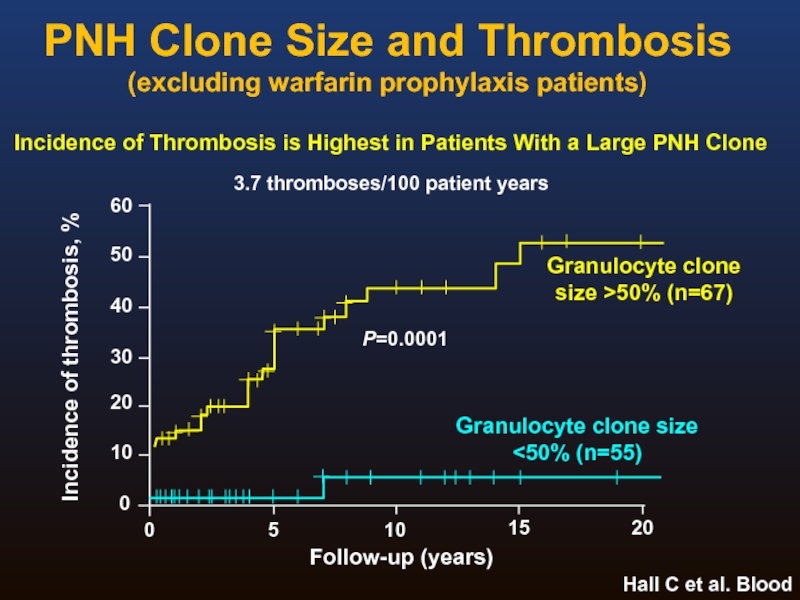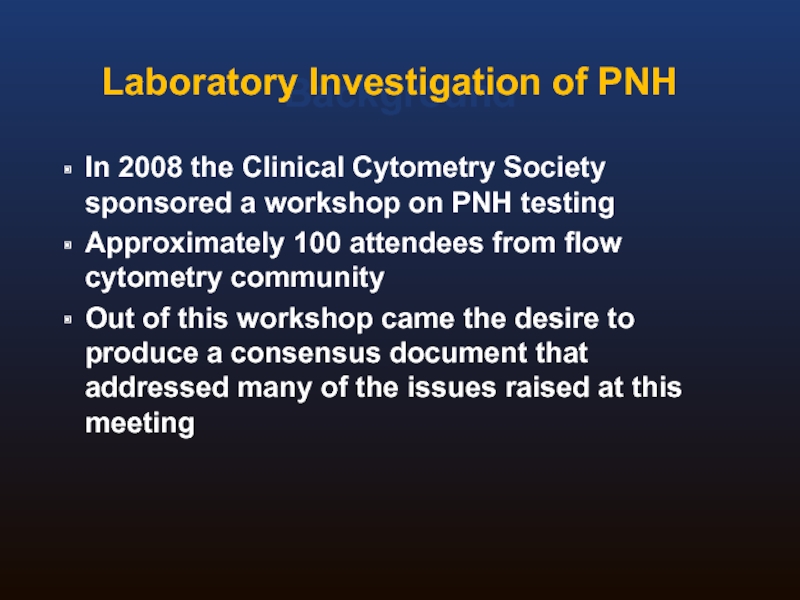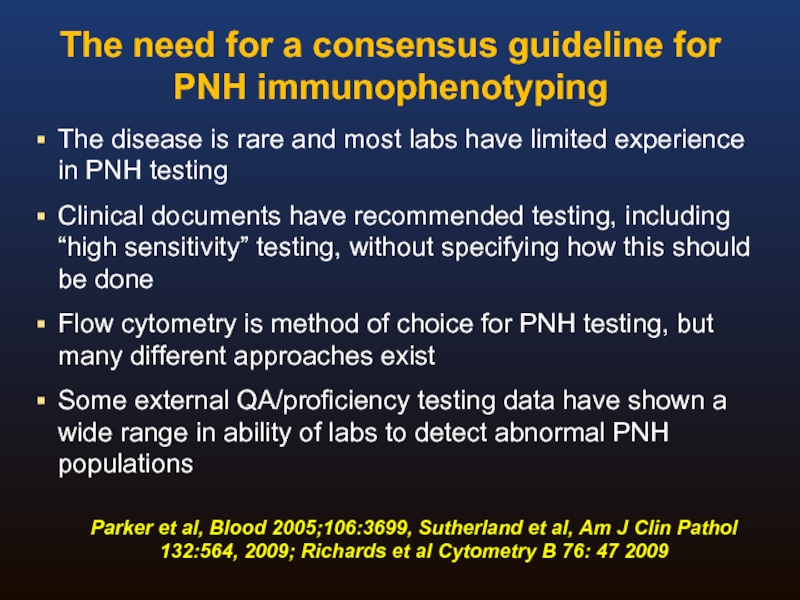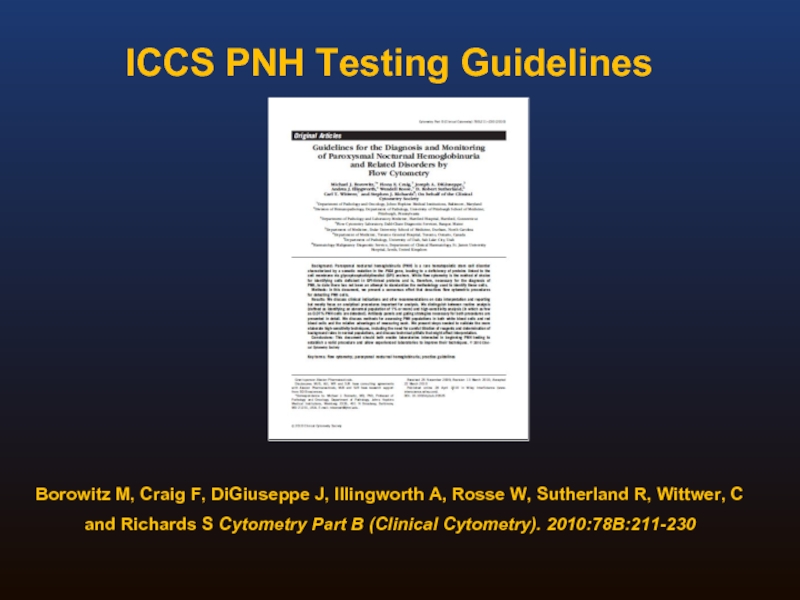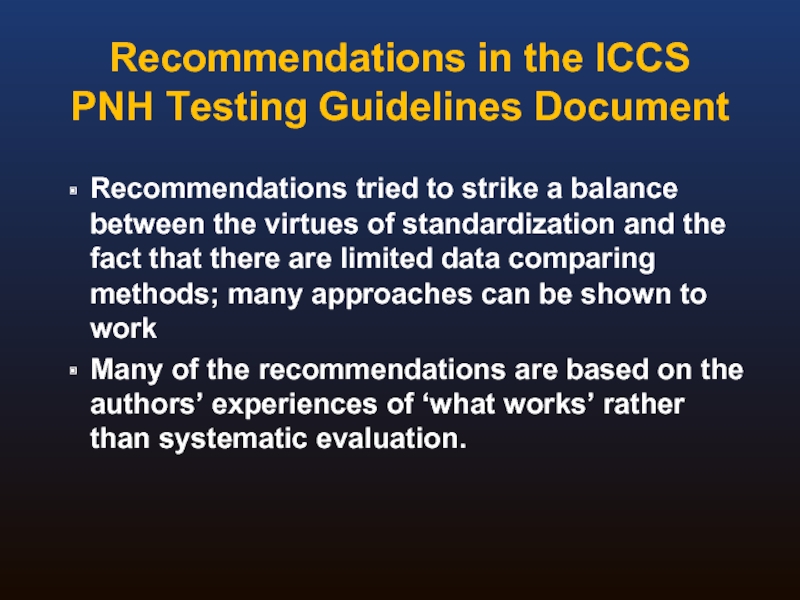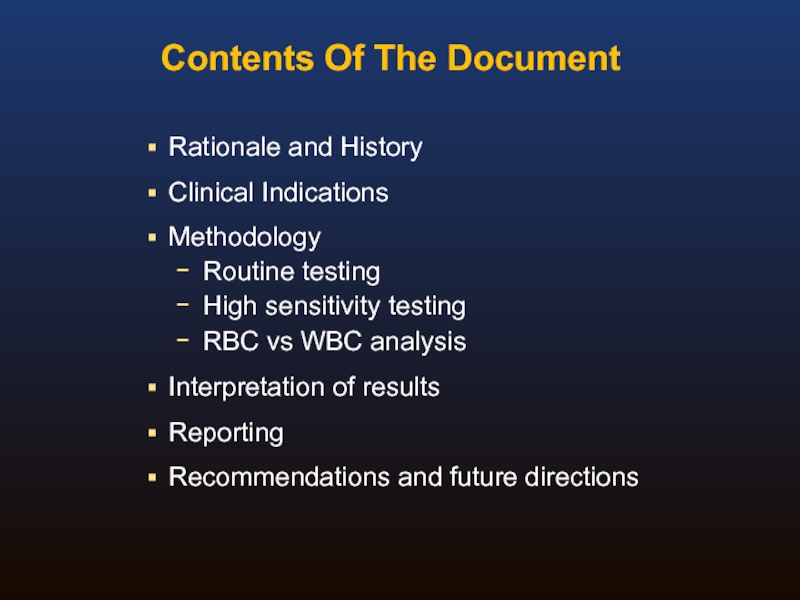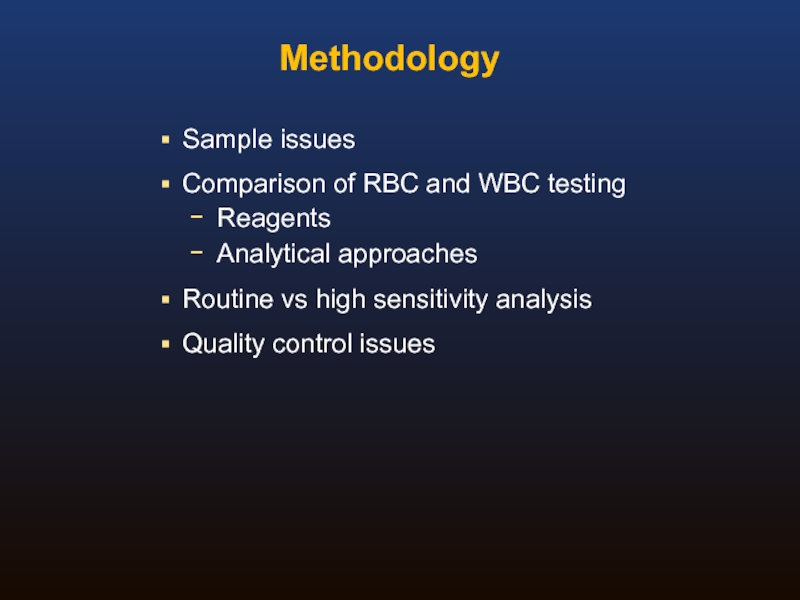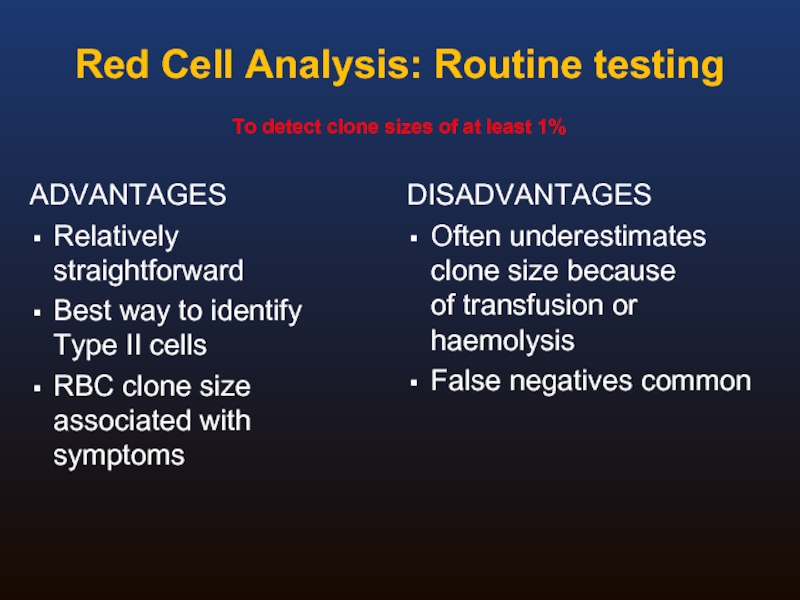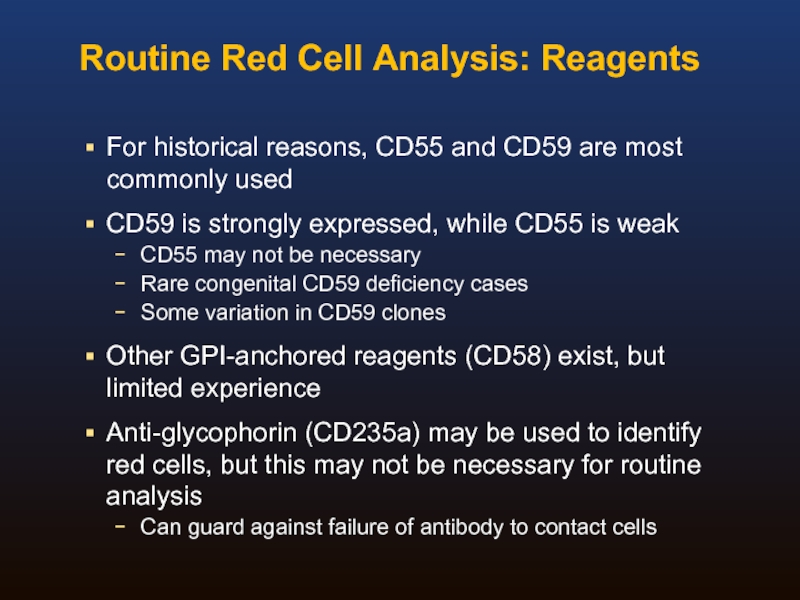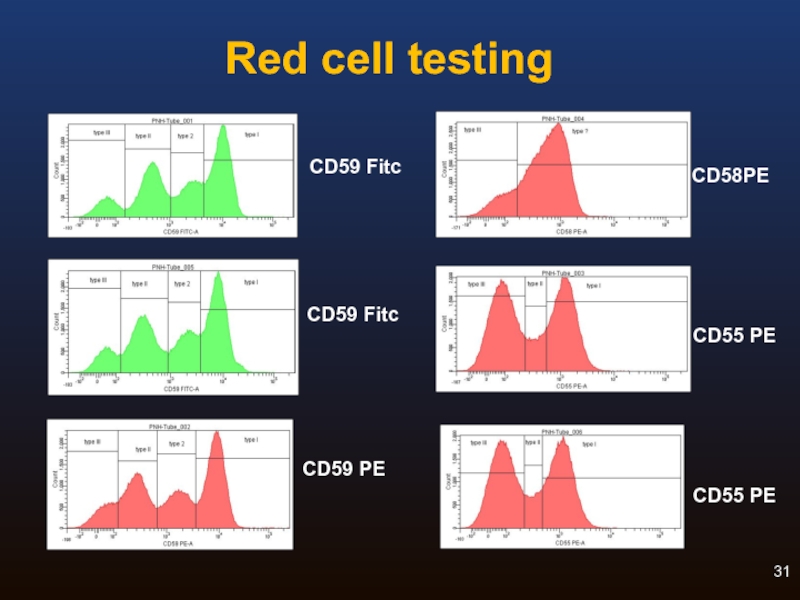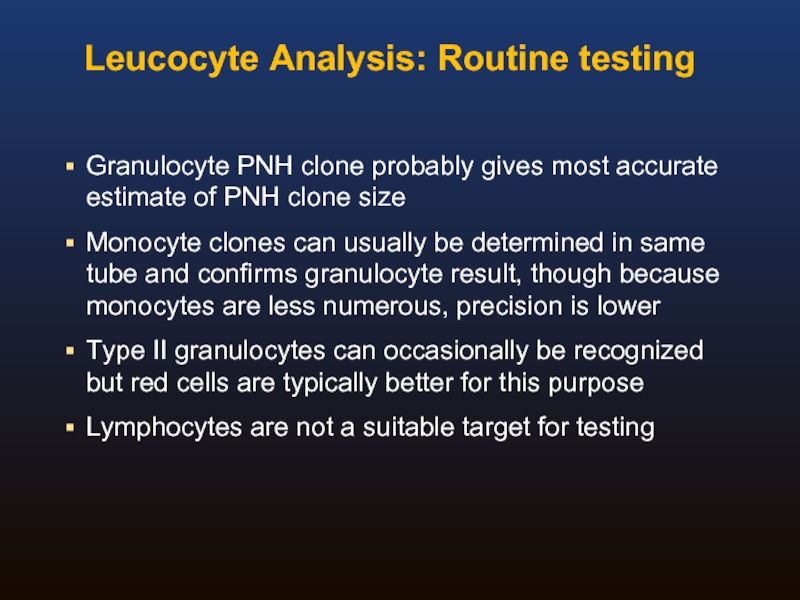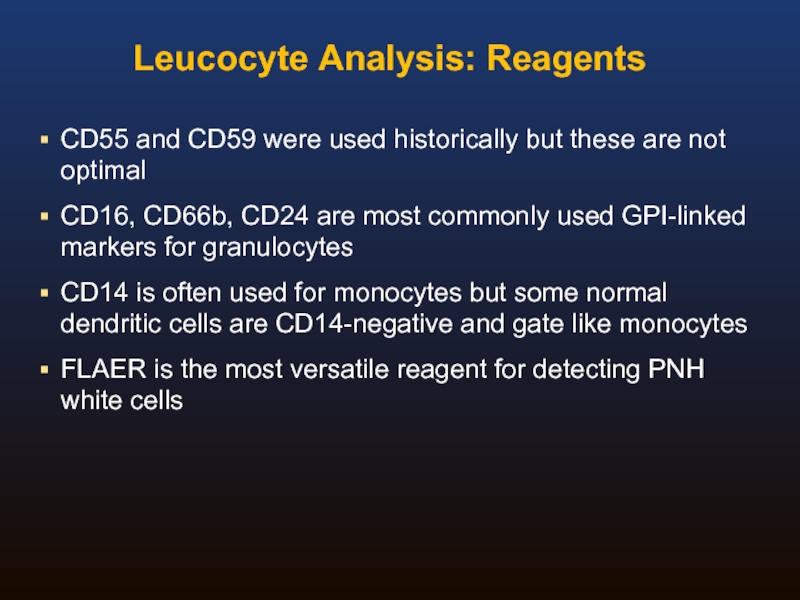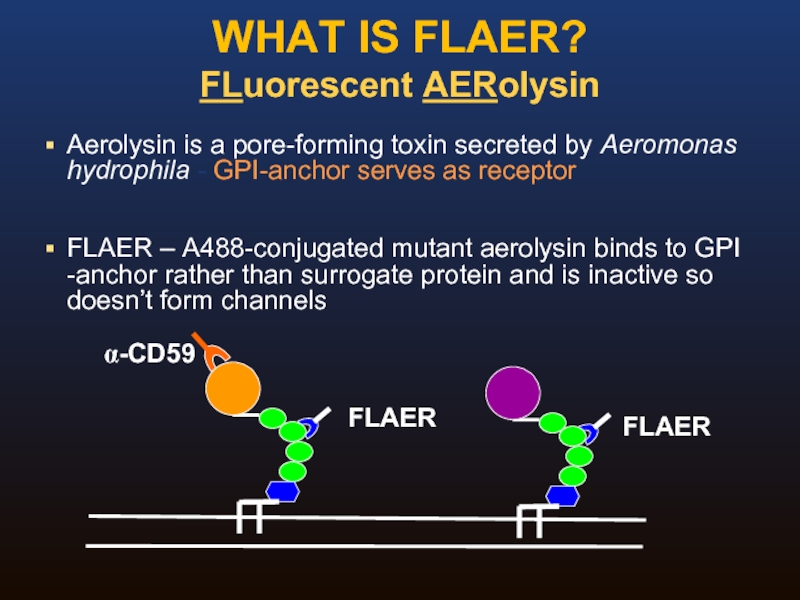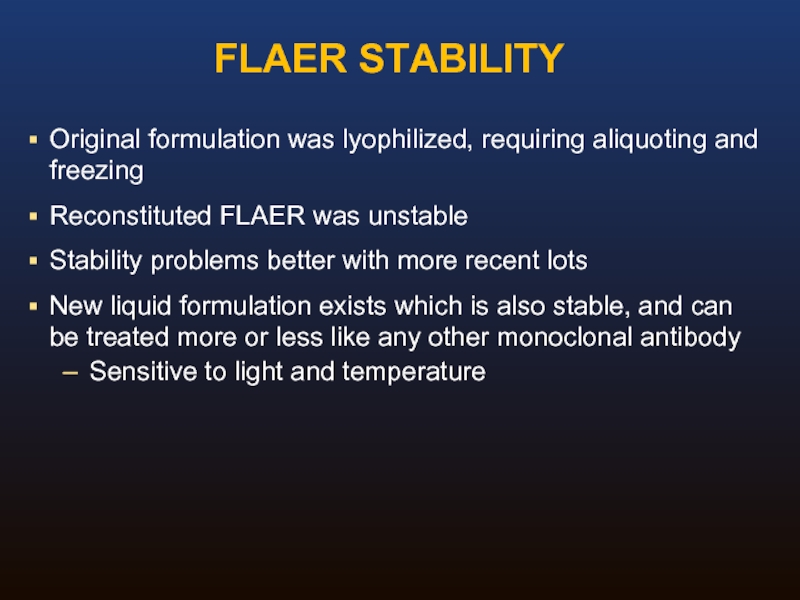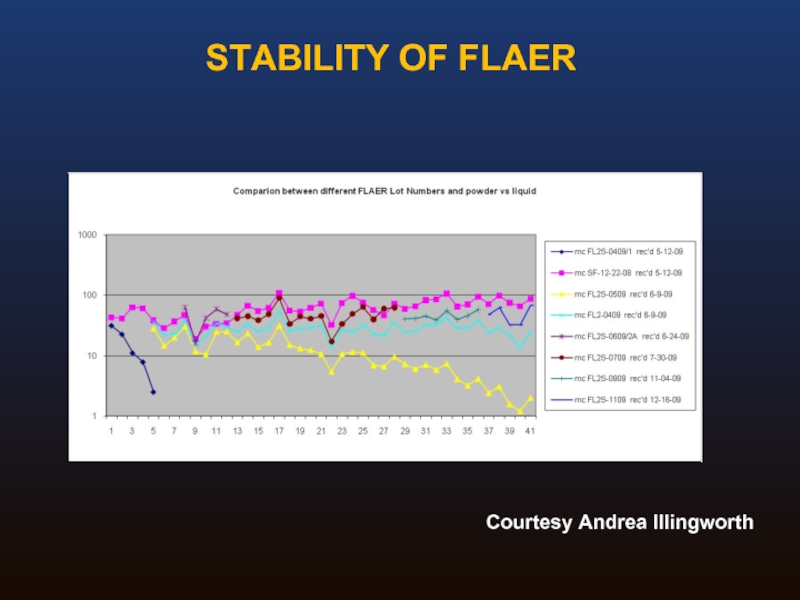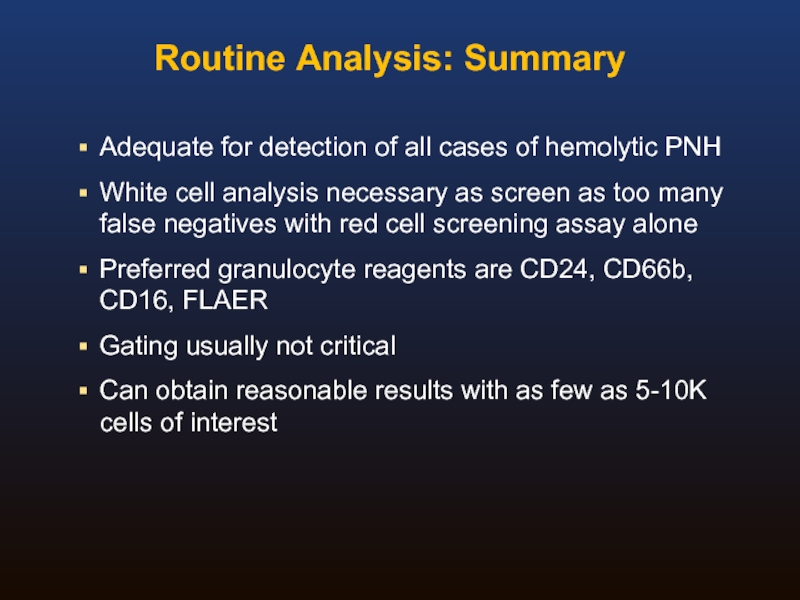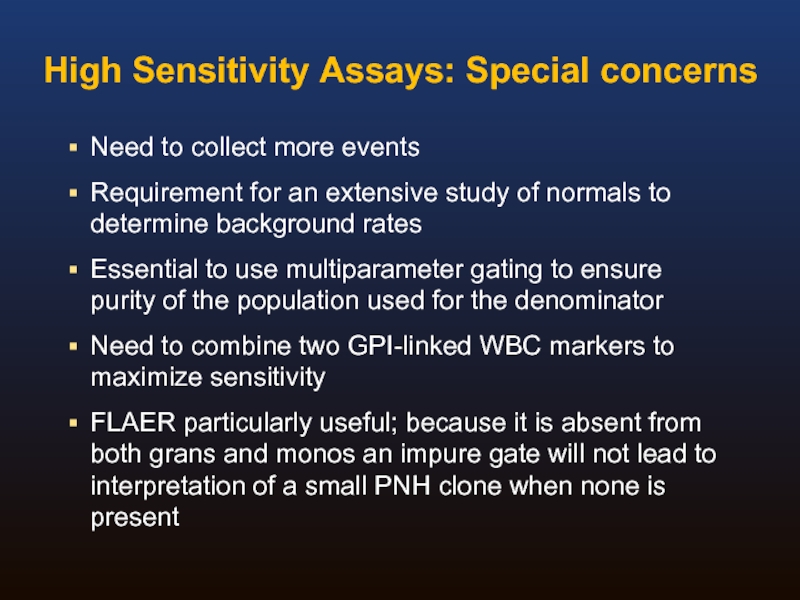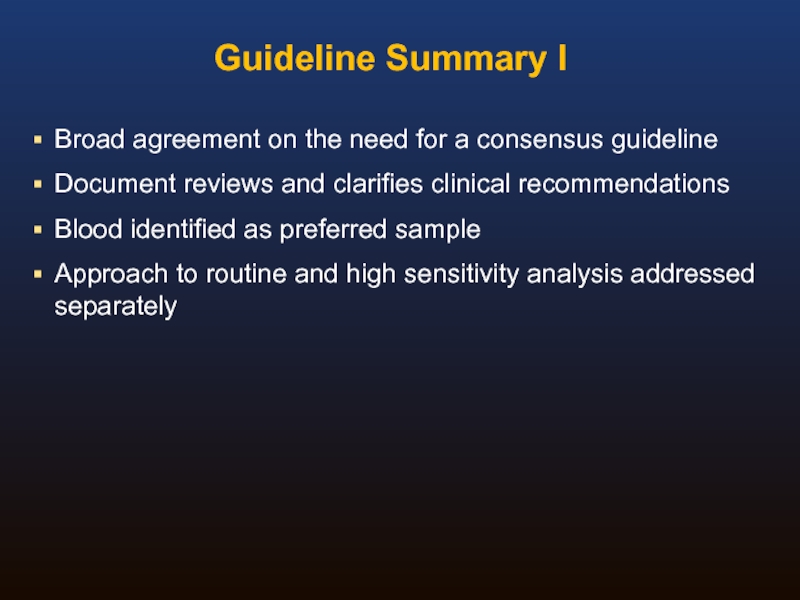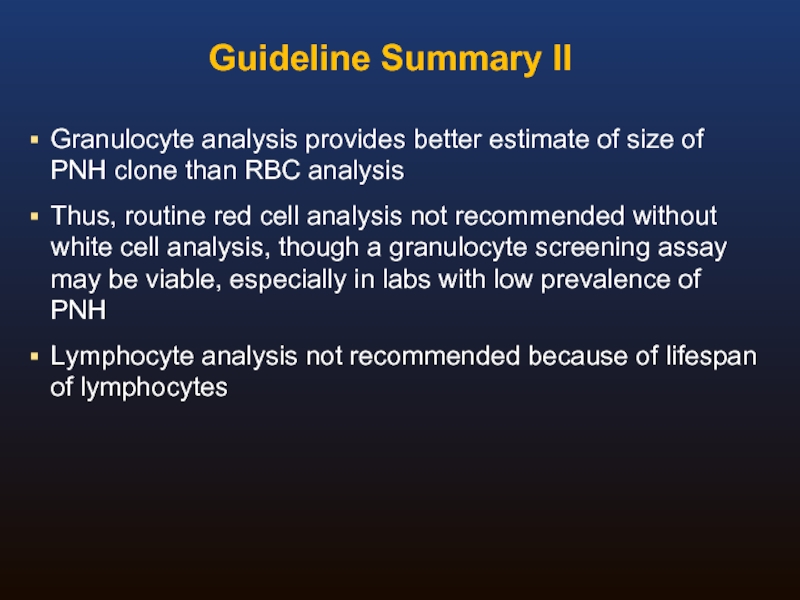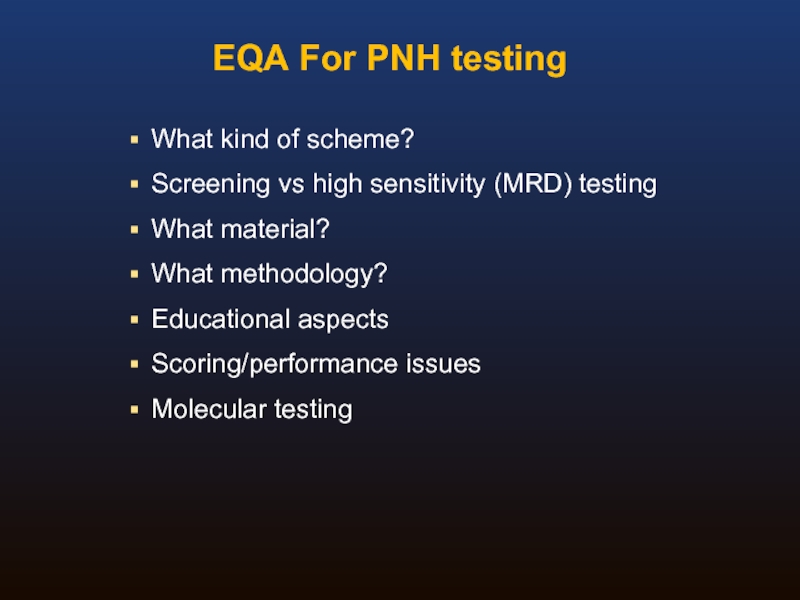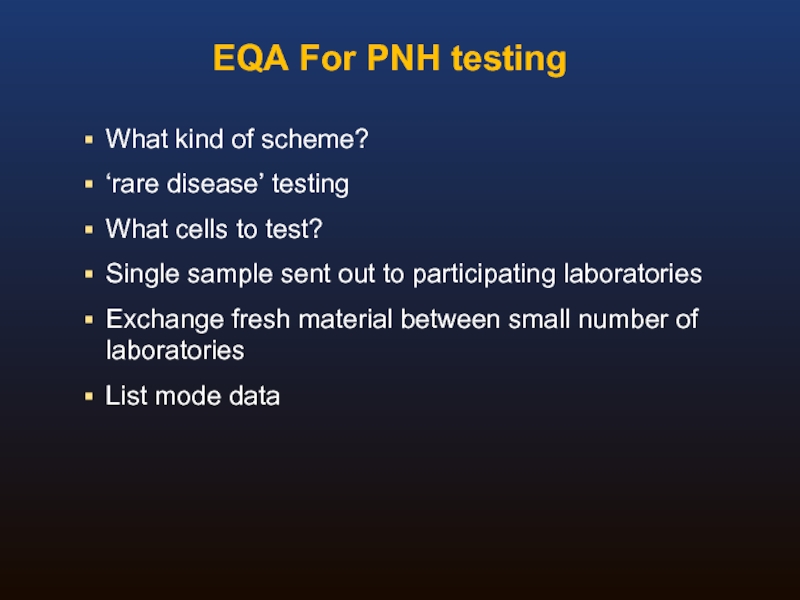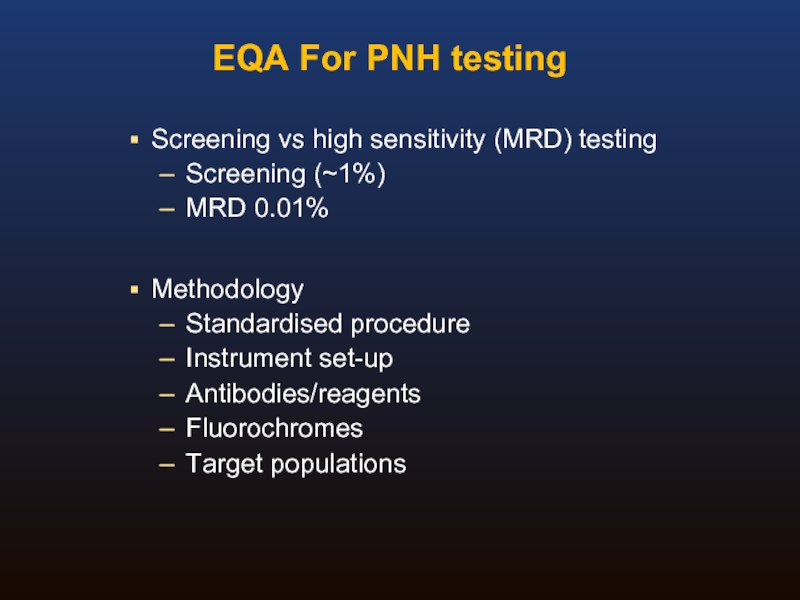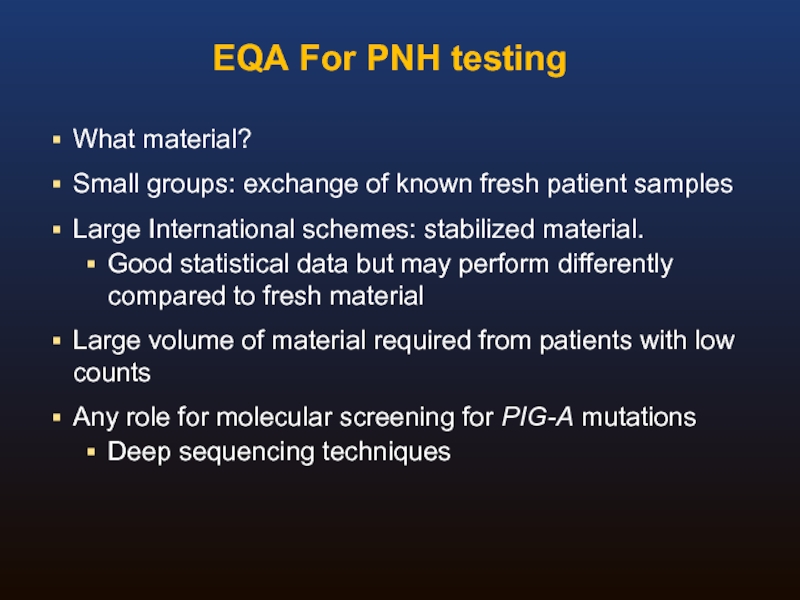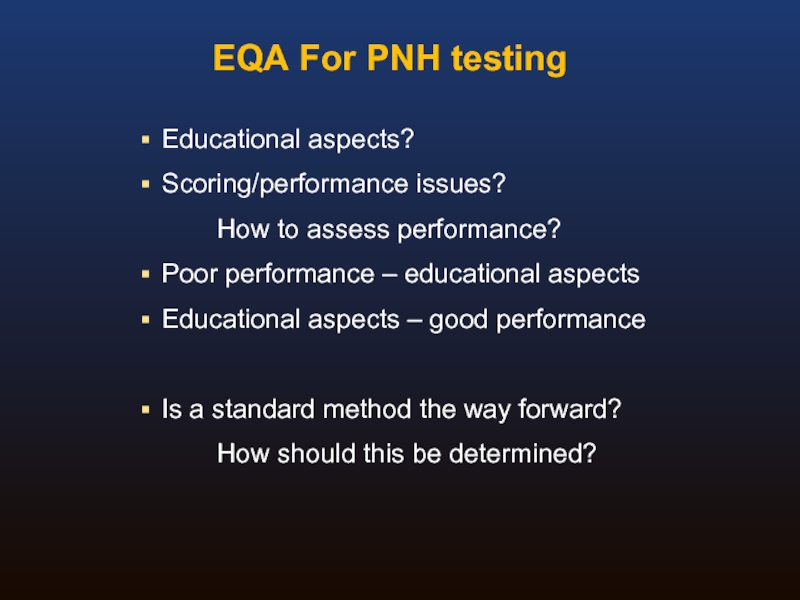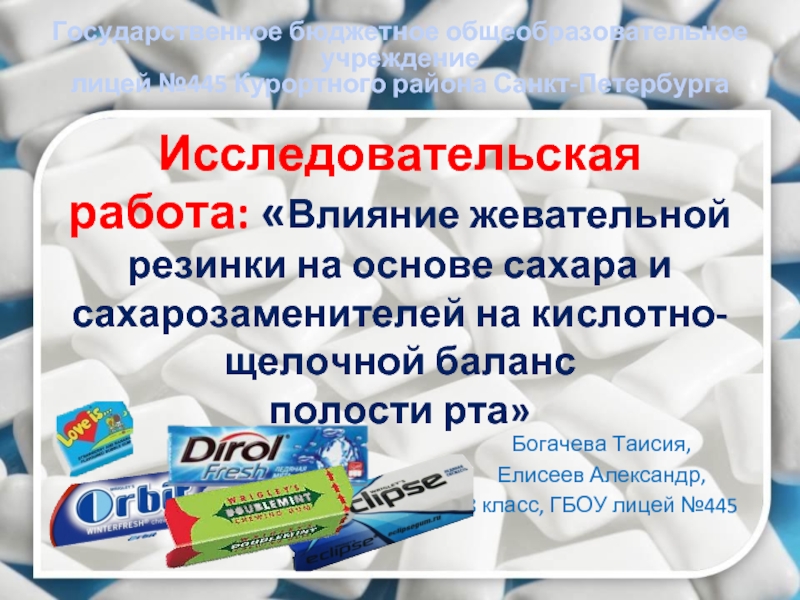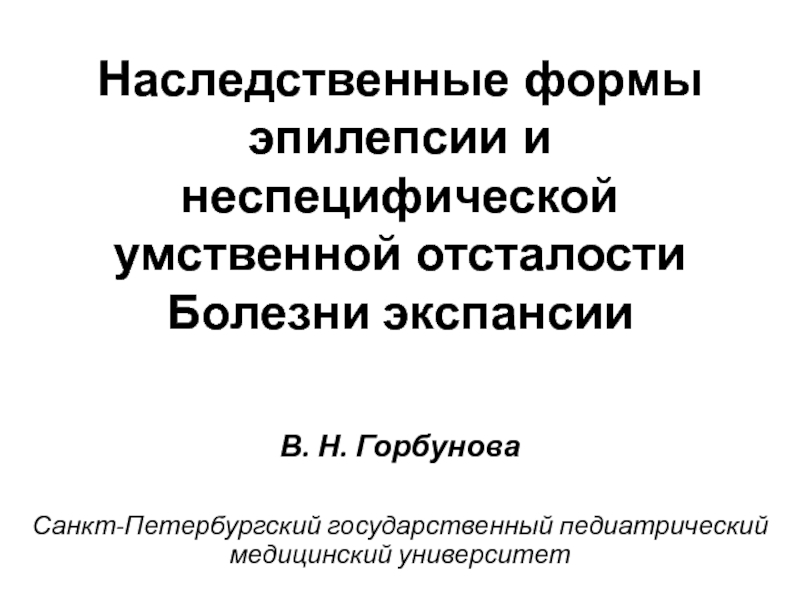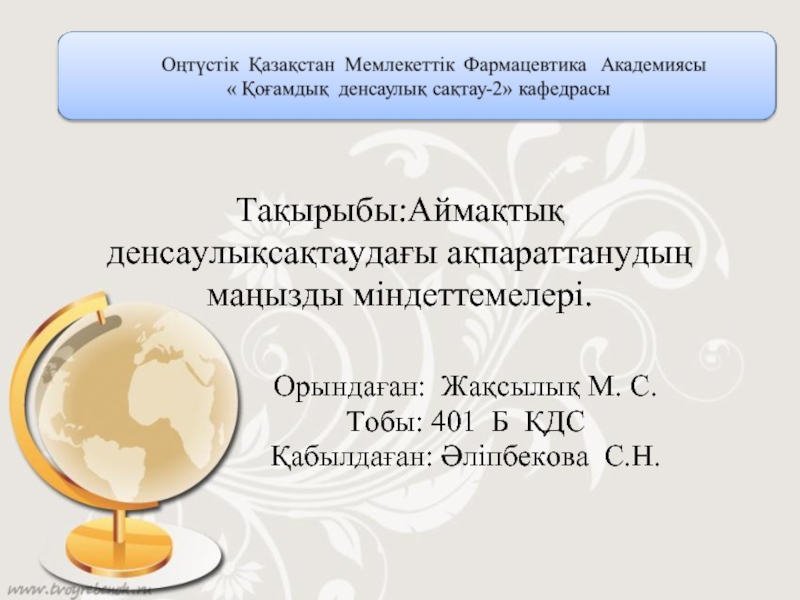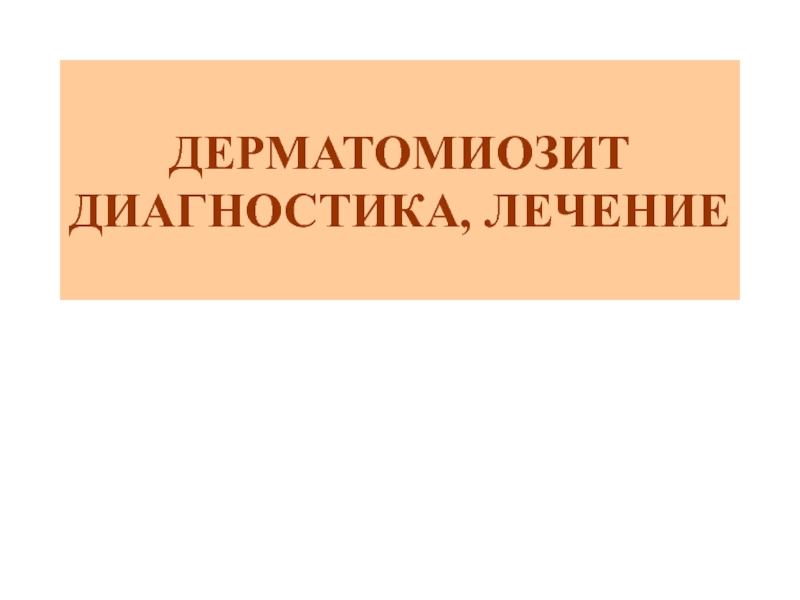- Главная
- Разное
- Дизайн
- Бизнес и предпринимательство
- Аналитика
- Образование
- Развлечения
- Красота и здоровье
- Финансы
- Государство
- Путешествия
- Спорт
- Недвижимость
- Армия
- Графика
- Культурология
- Еда и кулинария
- Лингвистика
- Английский язык
- Астрономия
- Алгебра
- Биология
- География
- Детские презентации
- Информатика
- История
- Литература
- Маркетинг
- Математика
- Медицина
- Менеджмент
- Музыка
- МХК
- Немецкий язык
- ОБЖ
- Обществознание
- Окружающий мир
- Педагогика
- Русский язык
- Технология
- Физика
- Философия
- Химия
- Шаблоны, картинки для презентаций
- Экология
- Экономика
- Юриспруденция
An overview of PNH: Pathophysiology, New Diagnostic Guidelines and EQA презентация
Содержание
- 1. An overview of PNH: Pathophysiology, New Diagnostic Guidelines and EQA
- 2. Paroxysmal Nocturnal Haemoglobinuria Clinical aspects of PNH New ICCS Guidelines EQA and PNH testing
- 3. Incidence and Prevalence of PNH in Britain
- 4. PNH – Triad of Clinical Features Haemoglobinuria
- 5. Proteins Deficient from PNH Blood Cells CD59,
- 6. Why does PNH occur? PNH clones Lack
- 7. Relative Growth Advantage in PNH Normal stem cells GPI-deficient (PNH) stem cells
- 8. Relative Growth Advantage in PNH
- 9. Relative Growth Advantage in PNH
- 10. Relative Growth Advantage in PNH
- 11. Natural History of PNH Four publications detailing
- 12. Natural History of PNH 1. Hillmen P,
- 13. Paroxysmal Nocturnal Haemoglobinuria: A Chronic Disabling and
- 14. Normal red blood cells are protected from
- 15. Symptoms and relationship to nitric oxide scavenging
- 16. Haemolysis and Nitric Oxide Red blood cell
- 17. Chronic Haemolysis is the Underlying Cause of
- 18. Renal Damage in PNH Chronic haemolysis and
- 19. Budd-Chiari syndrome Superior Sagittal Sinus Thrombosis Classical sites of venous thrombosis in PNH
- 20. PNH Clone Size and Thrombosis (excluding warfarin
- 21. Laboratory Investigation of PNH Flow cytometry immunophenotyping
- 22. Background In 2008 the Clinical Cytometry Society
- 23. The disease is rare and most labs
- 24. Consensus Committee Michael J Borowitz, MD, PhD
- 25. ICCS PNH Testing Guidelines
- 26. Recommendations in the ICCS PNH Testing Guidelines
- 27. Contents Of The Document Rationale and History
- 28. Methodology Sample issues Comparison of RBC and
- 29. Red Cell Analysis: Routine testing ADVANTAGES
- 30. Routine Red Cell Analysis: Reagents For historical
- 31. Red cell testing CD58PE CD55 PE CD55 PE CD59 Fitc CD59 PE CD59 Fitc
- 32. Leucocyte Analysis: Routine testing Granulocyte PNH clone
- 33. Leucocyte Analysis: Reagents CD55 and CD59
- 34. WHAT IS FLAER? FLuorescent AERolysin Aerolysin is
- 35. Original formulation was lyophilized, requiring aliquoting and
- 36. STABILITY OF FLAER Courtesy Andrea Illingworth
- 37. Routine Analysis: Summary Adequate for detection of
- 38. High Sensitivity Assays: Special concerns Need to
- 39. Guideline Summary I Broad agreement on the
- 40. Guideline Summary II Granulocyte analysis provides better
- 41. Guideline Summary III For high sensitivity WBC
- 42. EQA For PNH testing What kind of
- 43. EQA For PNH testing What kind of
- 44. EQA For PNH testing Screening vs high
- 45. EQA For PNH testing What material? Small
- 46. EQA For PNH testing Educational aspects? Scoring/performance
- 47. Acknowledgements Leeds NCG PNH Team Stephen Richards
Слайд 1An overview of PNH:
Pathophysiology, New Diagnostic Guidelines and EQA
Stephen Richards
stephen.richards2@nhs.net
St James’s
Слайд 2Paroxysmal Nocturnal Haemoglobinuria
Clinical aspects of PNH
New ICCS Guidelines
EQA and PNH testing
Слайд 3Incidence and Prevalence of PNH in Britain
Yorkshire population 3,742,835 (2001 census)
Incidence
Estimated prevalence 15.9/ million
Great Britain population 57,105,375
(2001 census)
estimated 75 new cases of PNH
per year
predicted prevalence of 908
patients
25% had PNH neutrophil clone size of > 50%
Hill et al., Blood, November 2006, 294a
Слайд 4PNH – Triad of Clinical Features
Haemoglobinuria
Intravascular haemolysis
→ disabling symptoms
abdominal pain
erectile failure
severe lethargy
Слайд 5Proteins Deficient from PNH Blood Cells
CD59, CD90, CD109
CD55
CD58
CD59 CD48
CD52
PrPc
CD16
CD24 CD55
CD58 CD59
CD48 PrPC CD73 CD108
CD55
CD58
CD59
CD109
PrPC
GP500
Gova/b
CD55
CD58
CD59
PrPC
AChE
JMH
Dombroch
HG Ag
CD55 CD58*
CD59 CD14
CD16 CD24
CD48 CD66b
CD66c CD87
CD109 CD157
LAPNB1 PrPC
p50-80 GPI-80
ADP-RT NA1/NA2
CD14 CD55 CD58*
CD59 CD48 CD52
CD87 CD109 CD157
Group 8 PrPC GPI-80
CD16
CD55 CD58*
CD59 CD48
CD52 CD87
CD108 PrPc
ADP-RT CD73
CD90 CD109
CD16*
Haematopoietic
Stem Cell
Platelets
RBC
PMN
B cells
Monocytes
T cells
NK cells
(Courtesy of Lucio Luzzatto)
Слайд 6Why does PNH occur?
PNH clones
Lack complement regulatory molecules and therefore probably
Have no malignant potential
Occur at low levels in normal individuals
BUT:
PNH “always” occurs with aplastic anaemia
Both rare disorders (1 in 100,000+) so unlikely to be chance
Dual pathogenesis theory
Dacie, 1980; Rotoli & Luzzatto, 1989
Слайд 11Natural History of PNH
Four publications detailing four groups on the natural
England: 80 consecutive patients between 1940–19701
USA and Japan: 176 (USA) and 209 (Japan) patients2
France, 2 reports:
220 patients between 1950–19953
460 patients between 1950–20054
1. Hillmen P, Lewis SM, Bessler M et al. New England Journal of Medicine 1995;333:1253-8
2. Nishimura J, Kanakura Y, Ware RE et al. Medicine 2004;83:193-207
3. Socie G, Mary JY, Gramont A et al. Lancet 1996;348:573-7
4. Peffault de Latour R, Mary JY, Salanoubat C et al. Blood 2008; Jun 5
Слайд 12Natural History of PNH
1. Hillmen P, Lewis SM, Bessler M et
2. Socie G, Mary JY, Gramont A et al. Lancet 1996;348:573-7
3. Peffault de Latour R, Mary JY, Salanoubat C et al. Blood 2008; Jun 5
4. Nishimura J, Kanakura Y, Ware RE et al. Medicine 2004;83:193-207
Слайд 13Paroxysmal Nocturnal Haemoglobinuria:
A Chronic Disabling and Life-Threatening Disease (1,2)
Estimated 4,000 –
5 year mortality: 35% (1)
Diagnosed at all Ages – Median age early 30’s (4,5)
Quality of life diminished (1,6)
Progressive disease (1,2)
100
80
60
40
20
0
0
5
10
15
20
25
Years After Diagnosis
Patients Surviving (%)
The expected survival of an age- and sex-matched control group is shown for comparison (1).
In a patient population where ½ the patients have <30% clone, 1 in 7 patients died by 5 years (7).
Actuarial Survival From the Time of
Diagnosis in 80 Patients With PNH (1)
Age- and sex-
matched controls
Patients with PNH
(1) Hillmen P et al. NEJM 1995; 333:1253-8; (2) Parker C et al. Blood 2005;106(12):3699-709; (3) Hill A et al. Blood 2006;108:985; (4) Moyo VM et al. BJH 2004;126:133-38; (5) Nishimura J et al. Med 2004;83:193–207; (6) Socié G et al. Lancet 1996;348:573-7; (7) Peffault de Latour R et al. Blood 2008;112(8):3099-106.
Слайд 14Normal red blood cells are protected from complement attack by a
Without this protective complement inhibitor shield, PNH red blood cells are destroyed (2,3)
Intact RBC
Free Haemoglobin in
the Blood from Destroyed PNH RBCs
Complement
Activation
Significant
Impact on
Morbidity (3)
Significant
Impact on Survival (3)
PNH is a Progressive Disease of Chronic Haemolysis (1-4)
(1) Rother R et al. JAMA 2005;293:1653-1662; (2) Brodsky RA. Blood Rev 2008;22:65-74;
(3) Rother R et al. Nat Biotech 2007;25:1256-1264; (4) Socie G et al. Lancet 1996;348:573-577.
Слайд 15Symptoms and relationship to nitric oxide scavenging
Dysphagia, abdominal pain & erectile
Attributed to smooth muscle dystonia due to the scavenging of nitric oxide by free plasma haemoglobin
From Sickle cell disease patients; Courtesy of Dr Mark Gladwin, NIH, Bethesda
Слайд 16Haemolysis and Nitric Oxide
Red blood cell destruction during haemolysis releases
cell-free
Cell-free haemoglobin scavenges NO (1)
NO depletion results in smooth muscle dysfunction – abdominal pain, dysphagia, severe lethargy, erectile failure
Reduced nitric oxide can cause pulmonary hypertension (2,3):
Vasoconstriction (1)
Clotting (1)
Platelet hyperreactivity (4)
Impaired fibrinolysis (5)
Hypercoagulability (5)
(1) Rother R et al. JAMA 2008;293:1653-1662; (2) Villagra J et al. Blood 2007;110(6):2166-72; (3) Hill A et al. Blood 2008;112(11):486; (4) Wiedmer T et al. Blood 1993;82(4):1192-6; (5) Grünewald M et al. Blood Coag Fibrinolysis 2003;14:685-95.
Слайд 17Chronic Haemolysis is the Underlying Cause of Progressive Morbidities and Mortality
Fatigue / Impaired
Quality of Life (3,4)
Abdominal pain
Dysphagia
Poor physical functioning
Erectile dysfunction
(1) Parker C et al. Blood 2005;106:3699-709; (2) Hillmen P et al. NEJM 1995;333:1253-58; (3) Rother R et al. JAMA 2005;293:1653-62; (4) Rother R et al. Nat Biotech 2007;25:1256-1264; (5) Socie G et al. Lancet 1996;348:573-577.
Слайд 18Renal Damage in PNH
Chronic haemolysis and cell-free plasma haemoglobin lead
to
Renal damage in PNH may be due to repetitive exposure of tissue to cell-free haemoglobin (3,4)
64% of patients with PNH have stage 1-5 chronic kidney disease (5)
Renal failure has been identified as the cause of death in approximately 8 – 18% of PNH patients (6,7)
(1) Parker C et al. Blood 2005;106:3699-3709; (2) Rother RP et al. JAMA 2005;293:1653-1662; (3) Clark DA et al. Blood 1981;57:83-9; (4) Hillmen P et al. NEJM 1995; 333:1253-8; (5) Hillmen P et al. Blood 2007;110(11):3678: Poster at American Society of Hematology 49th Annual Meeting; (6) Nishimura JI et al. Medicine 2004;83:193-207; (7) Rosse and Nishimura. lnt J Hematol 2003;77:113–20.
Слайд 19Budd-Chiari syndrome
Superior Sagittal Sinus Thrombosis
Classical sites of venous thrombosis in PNH
Слайд 20PNH Clone Size and Thrombosis
(excluding warfarin prophylaxis patients)
Hall C et al.
0
5
10
15
20
Incidence of thrombosis, %
Granulocyte clone size >50% (n=67)
Granulocyte clone size
<50% (n=55)
P=0.0001
Follow-up (years)
3.7 thromboses/100 patient years
Incidence of Thrombosis is Highest in Patients With a Large PNH Clone
Слайд 21Laboratory Investigation of PNH
Flow cytometry immunophenotyping is the method of choice
Diagnosis or identification of PNH cells by demonstrating deficiency of GPI-linked proteins from granulocytes/monocytes/red cells
There is little guidance or consensus on the best approach or for labs wanting to set up PNH testing
Слайд 22Background
In 2008 the Clinical Cytometry Society sponsored a workshop on PNH
Approximately 100 attendees from flow cytometry community
Out of this workshop came the desire to produce a consensus document that addressed many of the issues raised at this meeting
Laboratory Investigation of PNH
Слайд 23The disease is rare and most labs have limited experience in
Clinical documents have recommended testing, including “high sensitivity” testing, without specifying how this should be done
Flow cytometry is method of choice for PNH testing, but many different approaches exist
Some external QA/proficiency testing data have shown a wide range in ability of labs to detect abnormal PNH populations
The need for a consensus guideline for PNH immunophenotyping
Parker et al, Blood 2005;106:3699, Sutherland et al, Am J Clin Pathol 132:564, 2009; Richards et al Cytometry B 76: 47 2009
Слайд 24Consensus Committee
Michael J Borowitz, MD, PhD
Johns Hopkins
Fiona E Craig, MD
University
Joseph A DiGiuseppe, MD, PhD Hartford Hospital
Andrea Illingworth, MS Dahl-Chase Diagnostic Services
Stephen J Richards, PhD
NHS, Leeds UK
Wendell F Rosse, MD
Duke University
Robert D Sutherland, PhD
Toronto General Hospital
Carl T Wittwer, MD, PhD
University of Utah
Слайд 25ICCS PNH Testing Guidelines
Borowitz M, Craig F, DiGiuseppe J, Illingworth A,
Слайд 26Recommendations in the ICCS PNH Testing Guidelines Document
Recommendations tried to strike
Many of the recommendations are based on the authors’ experiences of ‘what works’ rather than systematic evaluation.
Слайд 27Contents Of The Document
Rationale and History
Clinical Indications
Methodology
Routine testing
High sensitivity testing
RBC vs
Interpretation of results
Reporting
Recommendations and future directions
Слайд 28Methodology
Sample issues
Comparison of RBC and WBC testing
Reagents
Analytical approaches
Routine vs high sensitivity
Quality control issues
Слайд 29
Red Cell Analysis: Routine testing
ADVANTAGES
Relatively straightforward
Best way to identify Type II
RBC clone size associated with symptoms
DISADVANTAGES
Often underestimates clone size because
of transfusion or haemolysis
False negatives common
To detect clone sizes of at least 1%
Слайд 30Routine Red Cell Analysis: Reagents
For historical reasons, CD55 and CD59 are
CD59 is strongly expressed, while CD55 is weak
CD55 may not be necessary
Rare congenital CD59 deficiency cases
Some variation in CD59 clones
Other GPI-anchored reagents (CD58) exist, but limited experience
Anti-glycophorin (CD235a) may be used to identify red cells, but this may not be necessary for routine analysis
Can guard against failure of antibody to contact cells
Слайд 32Leucocyte Analysis: Routine testing
Granulocyte PNH clone probably gives most accurate estimate
Monocyte clones can usually be determined in same tube and confirms granulocyte result, though because monocytes are less numerous, precision is lower
Type II granulocytes can occasionally be recognized but red cells are typically better for this purpose
Lymphocytes are not a suitable target for testing
Слайд 33Leucocyte Analysis: Reagents
CD55 and CD59 were used historically but these
CD16, CD66b, CD24 are most commonly used GPI-linked markers for granulocytes
CD14 is often used for monocytes but some normal dendritic cells are CD14-negative and gate like monocytes
FLAER is the most versatile reagent for detecting PNH white cells
Слайд 34WHAT IS FLAER?
FLuorescent AERolysin
Aerolysin is a pore-forming toxin secreted by Aeromonas
FLAER – A488-conjugated mutant aerolysin binds to GPI -anchor rather than surrogate protein and is inactive so doesn’t form channels
Слайд 35Original formulation was lyophilized, requiring aliquoting and freezing
Reconstituted FLAER was unstable
Stability
New liquid formulation exists which is also stable, and can be treated more or less like any other monoclonal antibody
Sensitive to light and temperature
FLAER STABILITY
Слайд 37Routine Analysis: Summary
Adequate for detection of all cases of hemolytic PNH
White
Preferred granulocyte reagents are CD24, CD66b, CD16, FLAER
Gating usually not critical
Can obtain reasonable results with as few as 5-10K cells of interest
Слайд 38High Sensitivity Assays: Special concerns
Need to collect more events
Requirement for an
Essential to use multiparameter gating to ensure purity of the population used for the denominator
Need to combine two GPI-linked WBC markers to maximize sensitivity
FLAER particularly useful; because it is absent from both grans and monos an impure gate will not lead to interpretation of a small PNH clone when none is present
Слайд 39Guideline Summary I
Broad agreement on the need for a consensus guideline
Document
Blood identified as preferred sample
Approach to routine and high sensitivity analysis addressed separately
Слайд 40Guideline Summary II
Granulocyte analysis provides better estimate of size of PNH
Thus, routine red cell analysis not recommended without white cell analysis, though a granulocyte screening assay may be viable, especially in labs with low prevalence of PNH
Lymphocyte analysis not recommended because of lifespan of lymphocytes
Слайд 41Guideline Summary III
For high sensitivity WBC analysis, essential to use an
FLAER and CD24 are recommended as preferred granulocyte reagents, and CD59 is the best single RBC reagent; CD55 is not acceptable by itself
Further research with other markers may result in revisions to these recommendations
Слайд 42EQA For PNH testing
What kind of scheme?
Screening vs high sensitivity (MRD)
What material?
What methodology?
Educational aspects
Scoring/performance issues
Molecular testing
Слайд 43EQA For PNH testing
What kind of scheme?
‘rare disease’ testing
What cells to
Single sample sent out to participating laboratories
Exchange fresh material between small number of laboratories
List mode data
Слайд 44EQA For PNH testing
Screening vs high sensitivity (MRD) testing
Screening (~1%)
MRD
Methodology
Standardised procedure
Instrument set-up
Antibodies/reagents
Fluorochromes
Target populations
Слайд 45EQA For PNH testing
What material?
Small groups: exchange of known fresh patient
Large International schemes: stabilized material.
Good statistical data but may perform differently compared to fresh material
Large volume of material required from patients with low counts
Any role for molecular screening for PIG-A mutations
Deep sequencing techniques
Слайд 46EQA For PNH testing
Educational aspects?
Scoring/performance issues?
How to assess performance?
Poor performance –
Educational aspects – good performance
Is a standard method the way forward?
How should this be determined?
Слайд 47Acknowledgements
Leeds NCG PNH Team
Stephen Richards Louise Arnold
Gemma
Peter Hillmen Tracy Downing
Angela Barlow Jane Bower
Anita Hill Richard Kelly
HMDS
Anita, Brad, Matt, Fiona, David Swirsky.
Alexion Europe
UKNEQAS LI
David Barnett, Liam, Alison, Matthew
CCS PNH Guideline team
Michael Borowitz and all who took time to read and comment on the document
Leeds NCG PNH Team
Thank you
